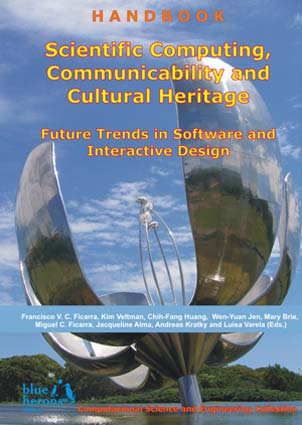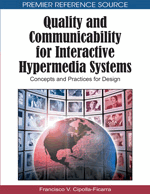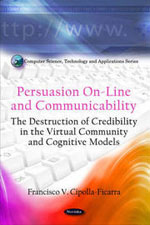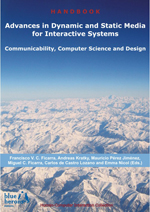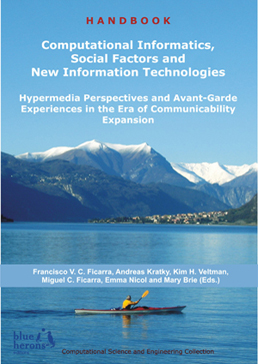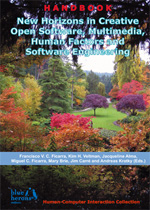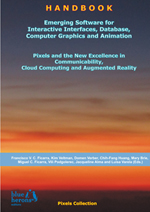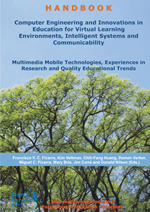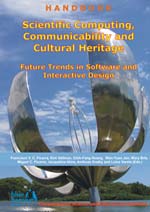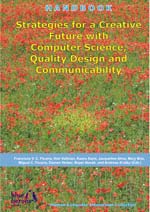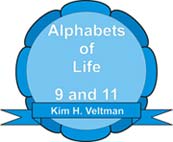Scientific Computing, Communicability and Cultural Heritage: Future Trends in Software and Interactive Design
:: Computational Science and Engineering Collection ::
:: Revised Selected Chapters ::
Main Editor: Francisco V. C. Ficarra
Co-editors: Kim Veltman (Maastricht, Netherlands), Chih-Fang Huang (Zhongli, Taiwan), Wen-Yuan Jen (Miaoli, Taiwan), Mary Brie (La Valletta, Malta), Miguel C. Ficarra (Spain and Italy), Jacqueline Alma (Vancouver, Canada), Andreas Kratky (Los Angeles, USA) and Luisa Varela (Perpignan, France)
Editorial Assistant: Jim Carré (Willemstad, Curaçao)
Book Details
• ISBN: 978-88-96471-11-1 :: DOI: 10.978.8896471/111
• Publisher: Blue Herons Editions
• Location: Italy (Bg)
• Subjects: Cultural Heritage, Internet, Software, Virtual Worlds, Lookable User Interface, ICT
• Subjects: Design, Mobile Geomatics, Higher Education, Games, Multimedia, 3D, Hologram
• Subjects: Communicability, Semiotics, Linguistics, Statistics, Graphics Information, CUDA
• Subjects: Radix Sort, Parallel Scan, GPU Architecture, Heuristic Evaluation, Spectasia, 2D
• Subjects: HCI, Genetic Programming, Hypercubes, Clustering, Hardware, Journalism, Web
• Subjects: New Media, Stereoscopic, DGGE Images, Informatics, VR, App, Data, Semantic
• Copyright: 2013
• Collection: Computational Science and Engineering
• Series volume: II
• Publication date: December, 2013
• Binding: Paperback
• Grade level: General
• Language: English
• Illustrations: Yes
• Colour: Yes
• Pages: 205
• Dimensions: 11.41x8.26x0.4 in. 1.21 lbs. :: 290x210x13 mm. 550 gr.
Preface
Books permit us to voyage through time, to tap the wisdom of our ancestors ... I think the health of our civilization, the depth of our awareness about the underpinnings of our culture and our concern for the future can all be tested by how well we support our libraries.
Carl Edward Sagan (1934 – 1996)
In the current book we explore the universe of digitality (bits) through three key areas which can be regarded as essential not only in the present but also in the mid to longer term future. These three cornerstones are scientific computing, communicability and cultural heritage. Although in principle they may sound incongruent to some readers among themselves; across the following pages it can be seen how there is a nexus and common denominator which has remained constant across the centuries.
Examples of the presence of such a synergy include; the need of calculation for the advancem of scientific knowledge, through to a requirement for qualitative communication which allows us not only to preserve the cultural heritage of human kind, but also projects the same energy towards the future as an industry of knowledge, without borders, and within everybody’s reach. In this sense, one of the people of the late 20th century who has best spread those ideas through the television has been Carl E. Sagan.
Since the remote times of human kind, man has tried to explain the phenomena of nature in daily life. This motivation has led him to create measurement tools. Tools which became more and more sophisticated and ever faster in terms of development; and in order to reach specific and exacting results, and always in the least possible time. In the late 20th century, with the democratization of the personal computers, the goods and services which were being generated and consumed daily in the great cities of the planet reached a milestone of 90% dependence on computer science and telecommunications.
In the new millennium, this percentage tends to reach 100% in the great cities of the five continents. Only a global blackout of the countless bits which now circulate through the information highways would confirm the veracity of such a statement. Nevertheless mankind's future world of digitally is clear; and these bits foreshadow a bountiful, rewarding and exciting future to be followed, thanks in large part to scientific computing. That is, mathematical models and numerical analysis to solve scientific problems; within arenas of endeavor belonging to the social sciences and engineering, for instance. Numeric analysis is the paramount element in the techniques used inside the computational sciences. It is precisely in this environment where the scientist and engineers develop software and computer applications to model systems. As a rule, these models require a great amount of calculation and are often carried out on supercomputers or platforms of distributed computing. The term “distributed” connotes in itself the use of the information networks, such as intranet, extranet and internet.
The information highways have widened the user base of computers in practically all the activities of citizens in their daily lives. Global access to these digital contents has required new devices, whereby mergers have taken place between existing devices and other inventions. Revolutionary developments have taken place within: industrial design, ergonomics and communicability; which are common terms in multimedia and mobile phones, for instance. On the other hand, the novel contents in these supporting frameworks have further increased the use of these communication tools in the current era of the tremendous expansion of communicability. Some contents allow us to boost the whole cultural wealth of the ancient civilizations; through wider access inherent in the dynamic and static means of multimedia communication. Taking into account all of these (seemingly) disparate developments, which are happening right now all across the planet; it has been decided to gather together related research works from each one of the aforementioned subject areas, and collate interesting chapters which are presented under each section of the handbook.
Some of the research works that make up the current compendium have been presented orally by their authors in the following international conferences, symposium and workshop: HCITOCH 2012 –Third International Workshop on Human-Computer Interaction, Tourism and Cultural Heritage: Strategies for a Creative Future with Computer Science, Quality Design and Communicability (Venice, Italy), HCITOCH 2013 –Fourth International Workshop on Human-Computer Interaction, Tourism and Cultural Heritage: Strategies for a Creative Future with Computer Science, Quality Design and Communicability (Rome, Italy), ADNTIIC 2013 –Fourth International Conference on Advances in New Technologies, Interactive Interfaces and Communicability: Design, E-commerce, E-learning, E-health, E-tourism, Web 2.0 and Web 3.0 (Huerta Grande – Córdoba, Argentina), HCITISI 2013 –Second Argentine Conference on Human-Computer Interaction, Telecommunications, Informatics and Scientific Information (Huerta Grande – Córdoba, Argentina), and SETECEC 2013 –Second International Conference on Software and Emerging Technologies for Education, Culture, Entertainment, and Commerce: New Directions in Multimedia Mobile Computing, Social Networks, Human-Computer Interaction and Communicability (Maribor, Slovenia).
The quality and originality of those presentations has been the reason for which the authors have been invited to enlargen their research works further, by submitting again new versions to an evaluation process of said proposals by the members of the international scientific committee. Consequently, these chapters have passed satisfactorily through a double process of international selection. In the next section a short introductory presentation of the research works that make up the current handbook is given:
Under the title “Historical Interfaces for Cultures” the author Kim H. Veltman carries out a splendid and masterful prologue. It serves as a kind of introduction to the current times, with a deep and comprehensive look at the past of humankind and its culture. Magnificently its author opens up new vistas of knowledge, complete with exacting details that delineate a resoundingly humanistic perspective, rich in real and historic examples, and stemming from each one of the remote places of our planet. We learn about the origins, evolution and future trends of the internet. The semantic study he has carried out about the contents of the phenomenon, growth and of the spreading of the web, has situates the reader at the crossroads of very interesting, illuminating and novel discoveries. Besides, the current work makes apparent the great validity of the disciplines related to the study of the languages to detect the need of new interfaces in view of the cultural heritage of human kind. Structurally, it is made up of the following sections: Introduction, Rahu and Ketu; Ouroboros and the Alphabet; Planets and Alphabets; La, Da, and Rho; and Conclusions. Finally a rich and variegated annex of references may serve as a guide for future lines of research; and for all those interested in delving into the main and secondary issues of the prologue.
Heather Moran, Fred McGarry, Don Cowan, and Clynt King are the authors of the chapter “A Proposed App Guide to The Toronto 2015 Pan Am/Parapan Am Games that Also Celebrates Local Indigenous Culture”. In this admirable chapter they present characteristics of an an App for smartphones and tablets as a free guide to the Toronto Pan Am/Parapan Am Games 2015, focusing excellently on information about the First Nations cultural heritage of the Greater Toronto Area. Included within this paper are details of, exceptional software App. It will provide games visitors with a wide-ranging cultural experience, whilst promoting Canadian pasts, the present and a also a shared future. Besides, each of the sections are very well divided and explained with figures and bibliographic references: books, magazine articles, etc. Finally, lessons learned, the conclusions and implications of the developed work; allow us to point out new roads for future investigations in the context of indigenous cultural heritage when applied to multimedia systems, for instance.
Alan Radley introduces us to his masterful research titled “Computers as Self: An Re-examination of the Relationship between Man and Machine”. Outlined is a most-valuable and distinguished self-centric philosophy of computer system design. He carries out a detailed study of the past/present/future of man-computer interactions/ relationships, and from the theoretical-technical point of view. Besides, a new protocol for electronic mail, named BitMail, is presented in this chapter, which is based on self-centric data. BitMail has several advantages over ordinary email systems, including faster and (potentially) infinitely larger file transfers, improved security and privacy, and a lack of unsolicited bulk messages or spam. He has built and tested an original “Lookable User Interface” named “Spectasia” which has efficiency advantages in terms of the rapid and efficient retrieval of digital information. In all of these areas, Alan situates the reached conclusions with respect to potential future lines of research.
Daniel Biga, Horacio Del Giorgio, Fernando Dufour, and Ariel Serra are the authors of the chapter “IMS (IP Multimedia Subsystem)”. They introduce all details of the IMS (IP Multimedia Subsystem) technology. In other words, it is a framework architecture for delivering IP multimedia services, which allows voice and multimedia applications to communicate from multi-access scenarios, for instance, Wireless, PacketCable, etc., thus allowing the convergence of fixed and mobile networks. Besides, the authors signal the importance of these issues within the academic field; since they have, in fact, identified new fields for research, in the near or longer term. Lastly, they use a simple and easy-to-follow language to introduce their findings, which proceed in an exemplary and progressive way along with the theoretical content. The concepts they use are very well defined in the first section of the chapter.
“Student’s Expectations to Using Interactive Whiteboards in Educational Activities from Higher Education” is the title of the magnific work presented by Liliana Mata, Iulia Lazar, Alina Diaconescu, and Gabriel Lazăr. The main goal of the authors is to present the results obtained in the use of interactive whiteboards (IWBS) in educational activities. The research work is developed in a simple and didactical way from the start; that is to say, finding out the context of the issues that have been approached in the research, and also carrying out a rigorous comparative of the state of the art in the integration of the new technologies inside the classroom, in the relatioinship between students, professors and the interactive whiteboards. For instance, the research also gathers an interesting collection of skills of professors and students inside the university context, in view of that technology and the obtained results. Results which have been obtained through a wide set of methodologies of heuristic assessment. Besides, the graphics introduced with the results facilitate the global view of the importance of the current study. Lastly, the comprehensive conclusions and the wealth in the bibliographical section denote the high theoretical and practical quality of the research carried out.
The author of the chapter “Teaching Programming Principles through Games” is Franc Jakoš. Said work constitutes an important field of reflection on the importance of the videogames in the learning process. Without any doubt the author presents an original way of approaching the “educational games without computer”. The author explains in a very detailed way one of the most commonly used strategies to increase the motivation in the learning process, such as the innovation in the use of games. Progressively, the content is made up by the following sections: Motivation, Related Work, Virtual Words as Teaching Environments for Programming, Conclusions and Future Work. The examples incorporated into each one of the sections which make up the article depict magnificently the success of programming with specialty resources of graphic computing, for instance. Without any doubt, it is a work where those professors interested in improving the quality of the teaching of programming can get an ideal help to reach that didactic goal.
“Construction and Optimization of Hypercube Clusters with Genetic Programming” is the title of the work submitted by its author: Matej Šprogar. The research starts with an accurate and concise introduction which denotes a correct use of the bibliographical references to shape the state of the art of the work. Later on the author explains each one of the aspects related to the monitoring of cell and genetic programming discovery of hypercubes, incorporating into the formulas used figures which facilitate understanding of the development of the issues approached. The examinations carried out make apparent the transcendence of the work carried out by the author, since the results obtained allow solution in an effective way of several of the problems enunciated in the introduction. The conclusions boost the degree of originality of the work carried out by Matej Šprogar.
Under the title of “Implementations of Radix Sort on GPU”, its authors, Bojan Novak and Domen Verber, describe in detail the implementation of the radix sort algorithm in the CUDA development environments. Following a step by step methodology, in each one of the areas into which the research work is divided, such Radix Sort, GPU Paradigm, Evolution of Sorting Algorithms, GPU Implementation of Radix Sort, Benchmarking, Application of GPU Based Radix Sort for Collision Detection, Particle Simulation, and Conclusions; the transcendence of the proposal made by its authors can be inferred. The set of formulas, figures, and three-dimensional representations make apparent the importance of the hardware and the software in the graphic computing of the current millennium. Besides, in the current work can be seen how; with financial resources in hardware, it is feasible to obtain quickly excellent results in the ever present equation of low costs and high quality. The article contributes to the spread of the democratization of graphic computing, among the different users who resort to a motley set of systems belonging to graphic computing, with a high level of realism for emulation and simulation.
María Angélica Pinninghoff Jüneman, Carola A. Figueroa Flores, Homero E. Urrutia Briones are the authors of a remarkable work with regard to a paradigm that arises from artificial life, for example, and more specifically ant colonies foraging behavior, whose title is “Using Ant Colony Systems for Edge Detection in DGGE Images”. The authors have compared different ant colony algorithms on a set of images, for the detection of edges, focusing on the study of DGGE (denaturing gradient gel electrophoresis) images. After the authors approach the main and secondary goals of the current work, the examples of the different figures which make up the article allow us easily to perceive the evolution of the work and the novel results obtained by the authors. Although structurally the article has the following main areas; abc, it is in the comparisons of the images where can be found quickly the quality of the annunciated proposal(s) and the excellent results obtained.
With the use of some simple initials like LUI (Lookable User Interface), its author, Alan Radley, develops an exemplary proposal with regard to a new philosophy of interfaces in the environment of human-computer interaction. His chapter is titled “Designing a Lookable User Interface: Strategies for Effective Human-Computer Interaction”. Gradually and splendidly the author introduces each one of the concepts he uses, explaining its meaning and the role they have in the context of the current proposal. Simultaneously, the examples that accompany the text allow to reflect in a novel way on a myriad notions related to the vision of the users, 2D, 3D, etc. These are valid concepts for the current and future vision systems in landline or mobile threedimensional environments, for instance. In the section “lookability experiments” he delves into the advantages of the interface he develops. Each one of the figures indicates masterfully the potentiality of that interface. Before summing up his conclusions, he introduces another novelty in the field of the 3D interfaces under the title of “Spectasia”. In few words, several 100% original ideas, are included as prototypes within the pages of the chapter.
The author of the research work “Statistical and Graphics Information Online: A Communicability Evaluation” stresses the importance of statistics in the interactive design of the online information in the development of digital newspapers. Although one of the main goals of the study is to focus on the adult users of personal computers and multimedia mobile phones, whose results are presented at the end of the chapter, another of the important goals is to analyze the origins of the statistics in paper support, and to detect the changes with the passing of time. In other words, the author intends to establish a first evolutional comparison of visual information aimed at statistic data, whether or not it is in analogical support, as in digital support. Besides, a universe of study has been made up to detect communicability failings between the users and statistic information. Starting from these, one can wipe them out from the layout and hence from content categories in the interactive systems. There are also examples stemming from the field of infographics and comics which include statistics in their composition. Finally, the results are presented of a heuristic evaluation with computer and multimedia mobile phones users.
Francisco V. C. Ficarra
Las Palmas de Gran Canaria, Spain (December 2013)
Partial Content On-line (pdf format)
• Front Cover (here)
• Preface :: Acknowledgment (here)
• Chapters :: Final Remarks :: Author Index :: Keywords Index :: References ... (here)
• Back Cover (here)
Additonal Handook Info
• Only paper copy – no digital book on-line and/or off-line –
• Special Price € 95 (expedition cost not included) ... e-Commerce :: Info Form
Welcome to Blue Herons Editions!
The origin of this publishing project is to be found in the Canadian lands, where nature presents itself generous in many places of its wide geography. More...
Education, Communicability, Design, Computer Science, HCI, Computer Graphics and Computer Animation:
We focus on education and new technologies with 33 years long experience. More...
Literature and Journalism:
Intersection between universal literature, local new journalism (true stories), sociology and legal immunity. Two collections:
- Casoncelli Bergamaschi
It is a typical bergamasque dough filled with meat, similar to the raviolis. More...
- Menjar Blanc & Black
It is a typical sweet of the Catalan coast and the Balearic Islands. More...
Others New Releases:
See all others new releases in books, CD, DVD, etc. More ...
Call for Papers: ADNTIIC 2015 :: HCITOCH 2015 :: SETECEC 2015 :: HIASCIT 2016 :: CCGIDIS 2015 :: IPCTIIC 2015 | HCITISI 2015 :: MSIVISM 2016 :: RDINIDR 2015

